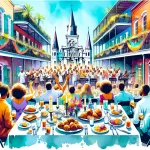Located at the heart of New Orleans is Treme, the oldest African American neighborhood in the United States, where a captivating blend of history, culture, and traditions flourishes. Treme and Mardi Gras Indian Cultural Tours offer an immersive experience, allowing visitors to explore the rich heritage of this iconic community and encounter the mesmerizing tradition of the Mardi Gras Indians.
In This Article
TL;DR
- Treme holds profound historical significance as one of the earliest African American neighborhoods in the United States.
- The Mardi Gras Indians represent a unique cultural expression, intertwining Native American and African traditions.
- Music, particularly jazz, is deeply interwoven into the cultural fabric of Treme and has greatly influenced Mardi Gras Indian traditions.
Understanding Treme: The Heartbeat of New Orleans
Treme’s origins date back to the late 18th century when free people of color and enslaved Africans settled in the area. Over the centuries, Treme has evolved into a vibrant neighborhood that embodies the essence of New Orleans culture. As you stroll through the streets, you’ll encounter key historical landmarks that speak to Treme’s rich past.
St. Augustine Church, constructed in 1841, stands as a testament to the faith and resilience of the community. It is the oldest African American Catholic parish in the United States and has played a significant role in the civil rights movement. Nearby, Louis Armstrong Park pays homage to the legendary jazz musician and the musical legacy of Treme. The park encompasses Congo Square, a historic gathering place where enslaved Africans would congregate on Sundays to dance, sing, and maintain their cultural traditions.
The Mardi Gras Indians: A Colorful Tradition
One of the most captivating aspects of Treme’s cultural landscape is the Mardi Gras Indians. This tradition dates back to the 19th century when African Americans, often excluded from mainstream Mardi Gras celebrations, formed their own tribes and created elaborate, hand-sewn costumes inspired by Native American attire.
The Mardi Gras Indian suits are a labor of love, with each intricate design taking months to complete. Adorned with vibrant feathers, beads, and sequins, these suits are a visual feast that showcases the artistry and dedication of the tribe members. The “Big Chiefs” lead their tribes through the streets of Treme during Mardi Gras and other special occasions, chanting and singing traditional songs that have been passed down through generations.
The Intersection of Cultures: African, Native American, and Creole Influences
Treme’s cultural tapestry is a result of the historical interactions between African slaves, Native Americans, and Creole populations in New Orleans. These interactions have shaped the unique expressions found in Treme and Mardi Gras Indian traditions.
The Mardi Gras Indians pay homage to the shared history of oppression and the bonds formed between African Americans and Native Americans. The intricate beadwork and designs on the suits often incorporate symbols and motifs from both African and Native American cultures.
Preserving these cultural traditions is an ongoing challenge in the face of modernization and gentrification. Community organizations and cultural institutions play a vital role in ensuring that the legacy of Treme and the Mardi Gras Indians is passed down to future generations.
Music: The Soul of Treme and Mardi Gras Indians
Music is the lifeblood of Treme, and jazz, in particular, has deep roots in the neighborhood. Pioneers like Alphonse Picou and Trombone Shorty honed their craft in the streets and venues of Treme, contributing to the evolution of this quintessential American art form.
The influence of jazz can be heard in the chants and songs of the Mardi Gras Indians, which often incorporate call-and-response patterns and improvisation. In turn, the rhythms and energy of the Mardi Gras Indians have inspired countless jazz musicians, creating a symbiotic relationship between the two cultural expressions.
Experiencing Treme and Mardi Gras Indian Cultural Tours
To fully immerse yourself in the culture of Treme and the Mardi Gras Indians, consider joining a guided tour. Treme & Mardi Gras Indian Cultural Tours offer an authentic and respectful way to engage with the community and learn about the significance of these traditions.
During the tour, you’ll visit historic sites, encounter Mardi Gras Indians, and sample delicious Creole cuisine. It’s essential to approach the experience with respect and an open mind, understanding that you are witnessing a living, breathing culture with deep roots and meaning.
Tours typically last around 2 hours and depart from the Treme Hideaway, located at 1223 Henriette Delille Street. Prices start at $25 per person, and advance reservations are recommended.
The Artistry of Mardi Gras Indian Costumes
The creation of Mardi Gras Indian costumes is a year-round endeavor that requires immense skill, patience, and creativity. Each suit is a masterpiece, featuring intricate beadwork, featherwork, and embroidery that tells a story and honors the tribe’s history and culture.
The materials used in the costumes range from traditional elements like beads and feathers to more contemporary additions like sequins and rhinestones. The process of creating a suit involves countless hours of sewing, beading, and adorning, with each element carefully placed to create a cohesive and stunning visual impact.
Renowned costume makers, such as Big Chief Darryl Montana of the Yellow Pocahontas Tribe, are celebrated for their artistry and dedication to the tradition. Their creations not only showcase their individual talent but also serve as a powerful expression of collective identity and pride.
Preserving Tradition: Challenges and Triumphs
Preserving the traditions of Treme and the Mardi Gras Indians is an ongoing challenge in the face of modern pressures such as gentrification, cultural appropriation, and the commercialization of Mardi Gras. However, the community has shown remarkable resilience and determination in ensuring that these cultural expressions remain vibrant and relevant.
Organizations like the Mardi Gras Indian Council and the Backstreet Cultural Museum play a vital role in safeguarding the legacy of the Mardi Gras Indians. They work to educate the public, support the tribes, and advocate for the preservation of these traditions.
One notable success story is the creation of the Mardi Gras Indian Cultural Campus, a collaborative effort between the Mardi Gras Indian Council and the New Orleans Center for Creative Arts. This campus provides a dedicated space for the tribes to gather, practice their craft, and pass on their knowledge to younger generations.
Engaging with the Community: How Visitors Can Support
As a visitor to Treme and a participant in Mardi Gras Indian Cultural Tours, there are several ways you can support the community and contribute to the preservation of these unique cultural expressions:
- Patronize local businesses, especially those that are owned by or support the Mardi Gras Indian community. This includes restaurants, art galleries, and music venues that showcase the talents of Treme artists and musicians.
- Visit cultural institutions like the Backstreet Cultural Museum and the New Orleans African American Museum, which offer exhibits and programs that highlight the history and traditions of Treme and the Mardi Gras Indians.
- Attend events and festivals that celebrate Treme culture, such as the annual Treme Fall Festival and the Mardi Gras Indian Super Sunday. These events provide an opportunity to witness the beauty and power of the Mardi Gras Indian tradition while supporting the community.
- Educate yourself about the history and significance of Treme and the Mardi Gras Indians, and share that knowledge with others. By spreading awareness and appreciation for these cultural treasures, you can help ensure their preservation for future generations.
Treme and Mardi Gras Indian Cultural Tours offer a window into a world of unparalleled beauty, resilience, and creativity. By experiencing these traditions firsthand and supporting the community’s efforts to preserve them, visitors can play a part in ensuring that the heartbeat of Treme continues to pulse with the rhythms of history, culture, and hope.
Contact Information:
Treme & Mardi Gras Indian Cultural Tours
P.O. Box 52014, New Orleans, LA 70152
Phone: (504) 975-5796
Website: https://tremeindiantours.com
Hours: Tours typically run on Saturdays and Sundays at 10:30 AM, lasting approximately 2 hours.
Prices: Tours start at $25 per person.






